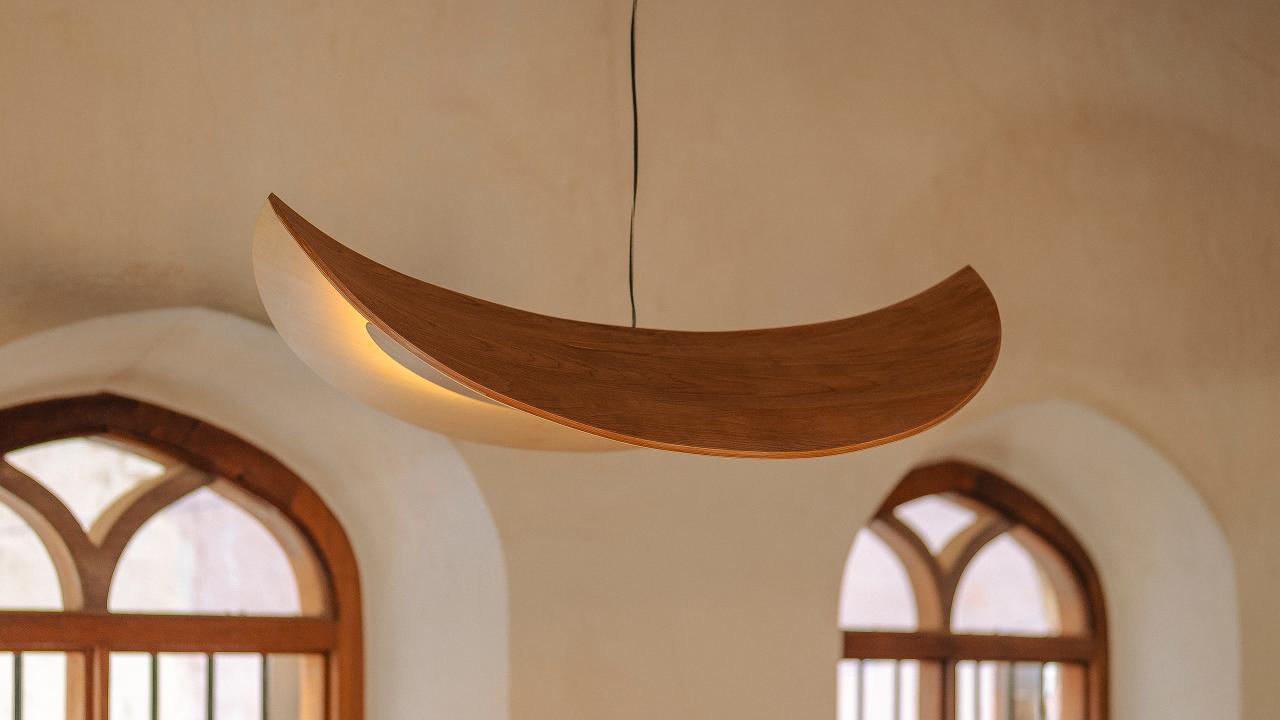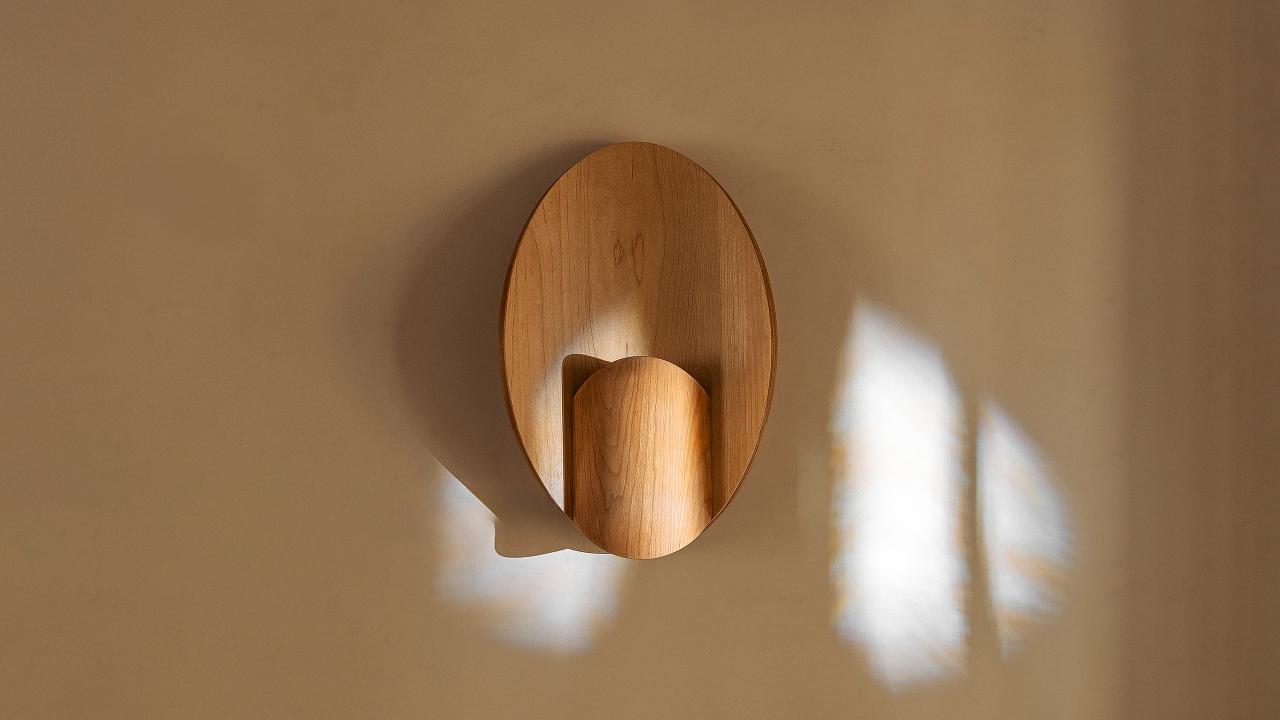"It was through AHEC that we could confront some of our misconceptions and biases around the use of non-indigenous species of hardwood. The expertise and knowledge about timber standards and woodworking processes that came along with the collaboration have been deeply educational. Through the development of the collection, we were able to quickly delve into the uncharted subject of wood bending and building forms and structures with them. Armed with Adam's proactive, rigorous, and patient insights we have been able to expand the range of our hand-crafted techniques and design language,” - Aparna Rao, Co-Founder, Phantom Hands.
The dining table, made from American red oak, is deceptively simple in structure, being two facing half cylinders, which have then been carved and shaped. The carving and shaping was done on-site, with a pencil, jigsaw and hand tools. According to Markowitz, two facing half cylinders is the simplest way to make a table with curves. However, you can barely read the initial cylinder shape at all in the final designs, as the handwork and sculpting has taken the form somewhere else (while retaining the structural logic of the half-cylinder).
“Whilst I initially set out to design a light, the table concept came quickly and unintentionally, and I think it is my favorite piece of the five. When the prototype was remade, I was asked to draw the shape in 3D so they could reference it for cutting out the legs - I instructed them to use the prototype itself as the reference, as the shapes I had drawn, and cut would be better than the shapes I drew on the computer. I think this is an important element of my process laid bare. On remaking the piece, we cross-laminated the veneer into plywood internally to reinforce the structure of the shape to give the piece additional rigidity,” - Adam Markowitz.
The bench is again looking to explore the strength of curves - both the seat and the legs are extremely thin, and would never be able to take the structural loads if they were flat. The curvature and the laminating process allows these benches to become very strong with minimal material. If you think of the seat as a curved beam, and the leg as a curved column, these two elements are incredibly strong individually, but when connected they also naturally resist racking forces. It is so strong that they were able to undermine the strength of the connection slightly to create a floating detail between the leg and the seat, to give a sense of this lightness and strength.
“I wanted to have seating to complement the table, and didn't dare attempt a chair given the timeframe. American red oak was chosen for both the table and benches for its warmth, with a connection to mid-century oak pieces, for its strength in this structurally challenging application, and for the consistency of its grain/color toning which meant that veneers could be readily matched. Building on my prior experience with lighting and the suggestion from Phantom Hands that it would be nice if there was a dialogue between the table and the lights, we also created two pendant lights and a wall sconce,” - Adam Markowitz.
Markowitz started with the idea of a shape which was ‘cut out’ of the legs of the table. Ultimately, they ended up making these without a center, but the first prototype was made that way, and they even used the offcuts from the table to test with for the lighting. The cutouts resulted in two curved, petal-like shapes, which spoke to the Wood Rose starting point given to Markowitz by Aparna Rao, Co-Founder of Phantom Hands. The challenge lay in intersecting these two shapes in different ways to find shapes that were strong, elegant, and worked to conceal and reflect the light source.
The Banana Leaf Pendant, named for its similarity to the Banana Leaf, intersects two petal shapes along their long edges, creating a curved central spine that is very strong. Each petal shape then flows out from this central spine in a convex shape that diffuses the reflected light. A third petal shape, suspended below the intersecting petals, hugs the curved form above tightly and conceals the light source. Similarly, the design approach to the Butterfly Pendant rotates these petal elements and joins them along their short edge, to create two bower-like concave forms reminiscent of a butterfly's wings to reflect and diffuse the light. A petal is inverted underneath, which again conceals the light sources.
“American cherry has been used for both pendants on account of its rich, warm tone, which helps to create an approachable vernacular quality to these sculptural shapes. Being hard and stable when dry, the wood is very easy to stain and finish to an excellent surface. It is thus highly prized for furniture and interior joinery. On the inside, a single skin of maple veneer is used - this has been chosen because of its lovely lighter tone whose brightness will more readily reflect and cast light. These two timbers work really well together with a gentle complementary contrast,” - Adam Markowitz.
In addition to the pendants, the wall sconce takes the two petal shapes and intersects them face to face to create a surface, which reflects the light, and a smaller shroud, which conceals the light source. In this piece, Markowitz expresses the intersectional quality of the design logic by showing the petal components passing through each other. This also creates opportunities to conceal wall mounting and wiring. Phantom Hands produced two wall sconces, a hardwired version and a plug-in version. One sconce was made with a blend of cherry & maple to match the pendant lights, and one sconce entirely in maple to really celebrate the qualities of this timber species on its own.





